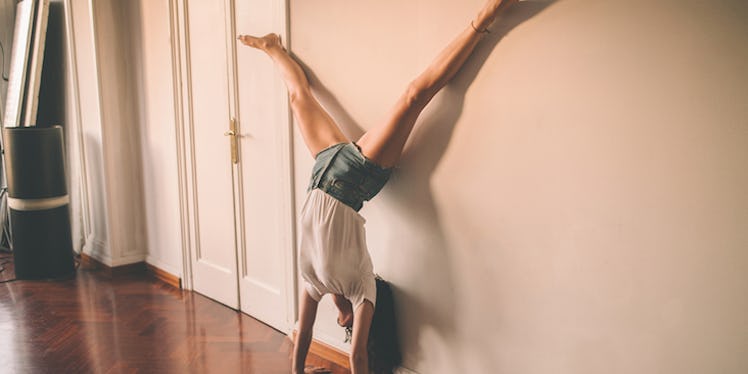
6 Ways To Finally Conquer Your Fear Of Going Upside Down And Nail A Headstand
I remember my first yoga class.
At the beginning of the class, I was hardcore-judging my vegan instructor's DIY dried orange earrings, but still excited to get into the flow.
By the end, I vowed never to do yoga again, because the instructor tried to talk me into doing a headstand.
I remember thinking how this woman must be out of her f*cking mind, because there is no way my whole body is going to be supported by my head.
I don't care if other people are doing it -- that's never going to be me.

Five years later, I'm a certified vinyasa teacher who doesn't let a day go by without getting upside down.
The bottom line is, if you're looking to conquer your fears of a headstand, and you don't know where to start, I'm here to assure you it's totally attainable with a few tweaks in both your practice, and your perspective.
Whether you're an avid yogi, or you just want to #DoItForTheGram, here are six ways to banish those inversion anxieties and nail your headstand in no time.
1. Work On Your Core

A strong core is the foundation of every yoga pose, but it's especially important when it comes to sticking a headstand.
The "abdominal lock" is known as uddiyana bandha (say that five times fast), and it's absolutely key to engage these mid-section muscles for a safe and stable headstand practice.
Incorporate ab workouts such as crunches, leg lifts, and plank variations into your daily routine to achieve killer core strength.
2. Strengthen Your Upper Body
Upper body strength is another big one when it comes to getting upside down.
Many people assume the majority of the weight in a headstand will be placed in their head or neck, but there actually shouldn't be any pressure in these areas at all when the pose is performed properly.
I like to practice commandos and push-ups to strengthen my arms for super sturdy inversions. Feel free to mix it up with your favorite arm exercises.
Plus, your triceps will look hella toned, too. Double whammy.
3. Use A Wall

The wall is an incredible tool when it comes to inversions.
It takes a lot of the fear away, because it's always there to catch you.
Take your headstand practice to the wall, and practice holding it there for longer and longer periods of time with each new attempt, until you feel strong and stable enough to stray away.
Be sure to always take child's pose after. The post-inversion dizziness of coming up too fast can be real AF.
4. Falling Is Good
OK, maybe not like that.
Yes, the wall feels comfortable and familiar, but it's important to take a little risk and move onto new and exciting things -- like the middle of the room!
I can't stress this enough: Falling is amazing.
Seriously, it shows that you're a badass who really put your all out there and tried.
It's scary as hell at first, but after you topple over a few times, you'll learn to laugh at yourself, not take things so seriously, and find fun in your practice.
5. Have A Strong Base

When you start practicing away from the wall, make sure your base is strong.
This means making sure your elbows are directly under your shoulders, and establishing a sturdy, firm foundation.
After that, you'll want to experiment with lifting one leg at a time to maintain control as you invert.
Remember to channel your core strength whenever you're tempted to use mindless momentum.
Setting up your headstand properly and breaking the pose down into steps (instead of just flinging yourself in the air) are crucial for perfecting your practice.
6. Enjoy The Journey

I know, it's a little cheesy.
But for real, doing a headstand is scary as sh*t.
Despite your fear, it's important to let the adrenaline excite you, rather than scare you.
And I know there's a lot of talk about "perfecting" and "conquering" here, but in the end, there's no such thing as perfect.
Everyone's practice is totally unique, and that's what makes it all truly exciting.